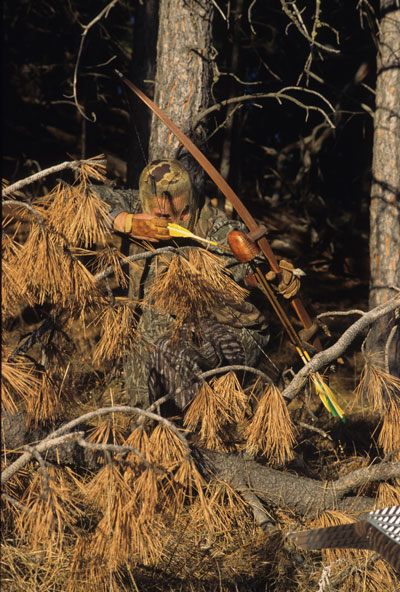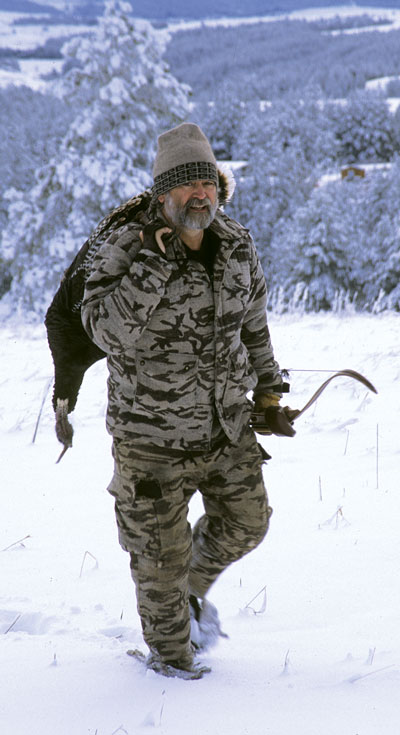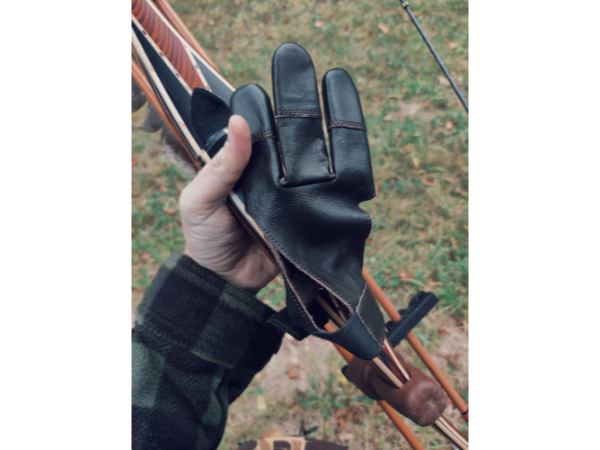They’re different birds in the fall.
I’d heard a single elk bugle somewhere up the mountain at first light. With no sign of the main herd I’d been dogging the last two days I decided to make the climb even though I wasn’t optimistic about locating the bull. When I popped over the top of a ridgeline half an hour later on the way up, a chorus of panicked putts erupted from the arrowhead balsamroot in the little park immediately below me. I’d blundered right into a flock of foraging fall turkeys, and they were as startled to see me as I was to see them.
They certainly didn’t waste any time reacting to the intrusion. Although I instinctively fumbled for a shaft, most of the birds were already airborne by the time I pulled one free from my bow quiver. For a moment the hillside looked as if a bomb had exploded and thrown pieces of bronze shrapnel in all directions. Stunned by the sound of all those straining wings, I watched the birds disperse and glide around the nearest contour line toward a small timbered basin. When the mountain air fell silent once more, I sat down on a weathered stump to wrestle with a decision.
A bugling bull elk—quite likely a big one given the quality of the bulls I’d seen in the area earlier—or a pile of feathers with a scrawny version of a Butterball buried somewhere underneath? Most bowhunters would regard that choice as a definitive no-brainer. But the bull was still a long way ahead of me up the mountain, and I don’t like blundering around in elk cover when my efforts are more likely to result in a spooked bull than a dead one. Besides, there’s a lot to he said for the proverbial bird in the hand as opposed to the bird (or bull) in the bush. And finally, if I were going to pack something off the mountain by myself in the 90 degree heat, did I want it to be an elk or a turkey? With a polite tip of my hat toward the distant, unseen elk, I began to angle down across the side hill toward the basin.

You’ll usually have to rely on natural “blinds” when hunting turkeys in the fall.
The contour allowed me to approach within a hundred yards or so of where I thought the birds had settled in behind a perfect eclipse. As soon as I reached the edge of the timber, I located a fallen ponderosa thick enough to provide good cover. After settling into a comfortable position that I could maintain without moving, I nocked an arrow—the very same broadhead-tipped cedar shaft I would have used on the elk—balanced my diaphragm call on my lower lip, and began to listen.
I honestly don’t know how much time passed before I heard the first turkey call below me. The soft kee-kee run that rose on the mountain breeze certainly wasn’t anything like the thunderous gobbles that define spring turkey season, but its meaning was every bit as specific. I knew the basin was about to come alive with turkey talk as the birds flew down from the trees and tried to reassemble, and I had to make some of them believe that the flock’s rendezvous point was right there at my ponderosa.
One of the many advantages a simple diaphragm elk call offers over all the more complicated competition on the market today is that it can be used to call a lot of different things — including turkeys. Although promoted as a sure fire means of coaxing a trophy bull into point blank bow range (yeah, right), mine produced a perfectly adequate stream of turkey chatter — mostly kee-kees with an occasional raspy old hen yelp thrown in to suggest the presence of the flock’s matriarch. I certainly wouldn’t have won any turkey calling contests, but in hunting situations there’s only one opinion of your calling that matters.
And within a few minutes it became apparent that I’d said something someone wanted to hear. A soft stream of purrs and yelps grew progressively louder until I could hear turkey feet scratching in the pine duff just beyond my log. I tried to time my draw to be at anchor when the first bird rounded the corner of the log, and for once (and I readily concede that my success owed more to luck than skill) I guessed perfectly. As soon as my thumb hit the corner of my jaw a turkey appeared less than ten yards away. But what kind of turkey?
It didn’t matter … and that’s one of the joys of hunting turkeys in the fall when, in most states, a bird is a bird is a bird. After mentally reminding myself to pick a spot—the right spot—no matter how close the target, I let my fingers go free and watched as my arrow turned the hen into a kabob. Despite all the troubles friends seem to have recovering turkeys I’ve always been fortunate in that regard, and by the time I stood up behind the log and glanced downhill the bird was fluttering her last on the forest floor.
Was a hen turkey really worth a detour away from a possible encounter with a bull elk? The following day I proved the question moot by calling in a 5-point, sending an arrow through his chest, and punching my tag. Even so, I like to think there would have been no regrets even if I hadn’t killed an elk that season.

Hunting fall turkey in deer season can mean coping with ugly weather.
Spring turkey hunting is one of the highlights of my outdoor year. It’s always a pleasure to be in the woods after a long Montana winter. While I’ve started spring turkey season in a blizzard more than once, the weather inevitably turns gorgeous sometime in April. And although many of my hunting friends assume I’m speaking hyperbolically when I tell them that I find calling in a gobbler just as exciting as rattling in a whitetail or bugling in an elk, the plain, dumb truth of the matter is that I mean it.
But we enjoy two turkey seasons here in Montana, and despite the limitations of the second I enjoy hunting — and eating — wild turkey too much to ignore it. Montana regulations allow us just one gobbler each spring (a conservative limit, since hunters have little impact on bird numbers when they’re shooting males in the spring) and a second bird of either sex in the fall. While the technical name of the quarry is Meleagris gallopavo in both cases, fall hunting differs so much from its spring counterpart that the hunter might as well be after two totally different species.
Whereas spring gobbler hunting is a fairly precise science — one might even call it ritualistic — the pursuit of fall birds is more likely to be a chaotic, helter-skelter affair. The hunt I described earlier represents classical technique for killing a fall turkey. Interestingly, of the twenty or so fall birds I’ve killed with a bow, only a handful died as the result of such deliberate effort. The vast majority fell while I was in the middle of dong something else, as targets of opportunity heavily flavored with luck. Even so, there are some tricks of the trade that will make it easier for the bowhunter to put real turkey on the table at Thanksgiving rather than a fat-laden substitute from the supermarket.
No matter what the season, the essence of successful turkey hunting means getting between where the bird is and where it wants to be while remaining undetected. The spring version of the method is simple in theory even if difficult in practice: hide, call, and convince an aroused tom that you’re where the action is. Absent the imperatives of the breeding season, fall birds make that far more difficult.
In autumn, foraging fall birds seldom respond to calls… unless you’ve broken up a flock, in which case by all means proceed as outlined earlier. Stalking turkeys at any time of year violates the principle outlined in the last paragraph, with good reason. If you’re new to the game and don’t understand why, just go try it sometime. Stalking antelope and whitetails may be difficult, but stalking turkeys is all but impossible, thanks to their extraordinary vision, sensitivity to motion no matter how subtle, and pattern-recognizing abilities. Of course there are exceptions to every rule, even this one…
Some years back, I was about to descend from a whitetail stand in the coulee behind my house when I spotted a handful of turkeys—the little group was too small to call a flock—pecking their way slowly along the floor of the draw below me. As I watched, they all disappeared beneath the rim of a rock ledge that looked as if it offered a total eclipse to within bow range. Leaving my gear in the tree, I lowered my bow, slid down like a monkey, and double-timed to the top of the ledge, where I nocked an arrow, came to full draw, leaned forward, and hoped. Amazingly, the birds were right there below me, and I sent my arrow whistling through the nearest bird’s thorax from ten yards away.
Absent a rare opportunity to make a similar entry in the better-lucky-than-good category or a conveniently busted up flock, you’re better off sticking with Plan A. When I see fall turkeys moving through the woods at a distance, I make a quick, educated guess as to their likely route of travel, make a wide circle and get way out ahead of them, find a fallen log or similar natural ground blind, and wait. Of course, most times I either never see the birds again or watch them walk by well out of bow range, but the odds of a reasonable shot are still better than anything a more aggressive strategy might offer.
So just what constitutes a “reasonable shot” at a fall turkey? At the risk of writing something likely to be misconstrued with unfortunate results, I can only tell you that if you aren’t willing to test the limits of the envelope, you shouldn’t be hunting fall turkeys. I am absolutely not endorsing irresponsible Hail Marys. Under any circumstances, a turkey needs to be close to be an ethical target. I’m not going to throw out a number in yards because too many variables affect the decision; like art or pornography, you’ll know it when you see it. But the wait for a perfect, stationary shot is likely to be a long one. While I don’t shoot at running turkeys, I will shoot at birds walking at speeds that would likely make me hesitate and hope for something better on a deer. The reason is simple: fall turkeys are almost always moving.
One December past, Lori and I were out looking for lion tracks when I spotted a large flock of turkeys working their way along a snow-covered draw. It looked to me as if they would likely pass through a natural bottle-neck with a little encouragement, so I sent Lori around to set up in position while I hooked around in the opposite direction to start a gentle, low key turkey drive. The strategy appeared to work like a charm, but when I met up with Lori she still had all of her arrows in her quiver. “Look at this!” I said, pointing to the tracks in the snow. “You must have had birds right on top of you!”
“I did!” she gasped. “But none of them ever held still long enough for me to shoot!”
I’ll never criticize anyone for passing up a shot with a bow. I didn’t do so then and I’m not doing it now. The fact remains that if you’re not willing to take a shot at a mobile, jittery bird, you’re not hunting fall turkeys. Of course, when a bird does slow down and offer a slamdunk at close range, the usual response is to feel such a rush of disbelief that you hurry the shot and miss. Damned if you do, damned if you don’t.
A lot of us spend time in tree stands in the fall, which raises a logical question: do tree stands offer the same kind of close range advantage on turkeys as they do on deer? The conventional answer is: no. With good reason, since turkeys face regular predation from raptors, they’re naturally wary of danger from above. However, there are exceptions to every rule and two facts illustrate the conundrum. 1. I have never killed a turkey from a tree stand even though there are plenty of turkeys in the woods around my house where I hunt deer. 2. I have missed two I should have killed, for precisely the reason noted in the last paragraph. And not all turkeys are created equal. Hunting whitetails with friends in Iowa a few years back, I decided I might take a crack at one of the big eastern gobblers frequenting the area. Although I heard several flocks of turkeys daily, every one began to putt in alarm at the exact instant I made eye contact with the birds coming through the woods. By the end of the trip, I was convinced that the birds could hear me think. Perhaps our gorgeous western Merriams really are dumber than the birds back east.
Despite all of these confounding factors, fall turkeys do offer a few advantages over spring birds. They usually just aren’t quite as sharp. Good thing; since I usually run into them when I’m out on the ground hunting elk or mule deer, it’s reassuring to know that simply standing still behind a tree will often do the trick in circumstances that would send a wary spring tom into hyperspace. Second, there’s no need to worry about what kind of turkey is coming up over the ridge at you, at least in Montana and other states that allow hunters to kill any turkey during the autumn season. I’ve actually never shot a longbeard in the fall, and on several occasions have preferentially taken a hen rather than the gobbler standing next to her simply because I’d prefer to have the tom around the following spring. Finally, there’s the table quality of the bird to consider. Friends who don’t like to eat wild turkey — or certain kinds of wild turkeys, like big toms — frankly drive me crazy. I’ve eaten dozens and dozens of them and never had one that was anything less than excellent. But after a long summer of leisurely feeding, late season birds are almost always better, and a plump hen turkey taken in the fall makes one of the most delicious game meals imaginable.
Of course there are big game trophy fanatics among us who would never risk an opportunity at a big buck or a bull just for the sake of a turkey, and I respect that position. I’m just not one of them, which is why I’ll likely never be in the running for the title of World’s Most Successful Bowhunter. But if, like me, you hunt for challenge and fun, check your state’s fall turkey regs and prepare to enjoy whatever opportunities the rules allow.
And one final word of advice: pack a full quiver of arrows.
Equipment Note: Don has probably killed a turkey or two with every bow he owns and has no strong feelings on that subject. But a turkey’s breast keel can be as tough to penetrate as a deer rib, and despite the modified turkey heads on the market now he still prefers a solid, traditional 2-blade head for maximum penetration. Almost all of his fall birds have fallen to Magnus heads.







Leave A Comment